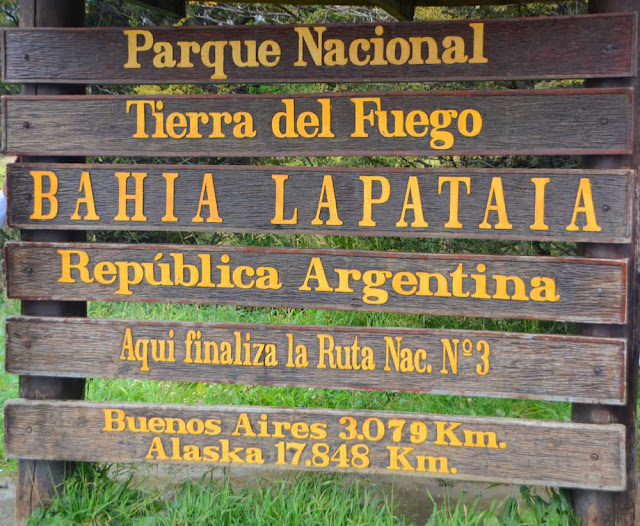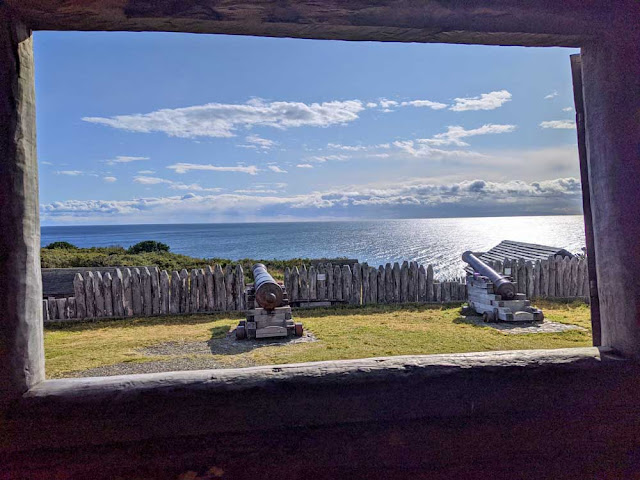Our second Punta Arenas of the trip, this one considerably south of the first. I was expecting a small, barren town here at the end of Chile, but it's a good sized town of prosperous people. We chose the bus tour to the original fort established by Chile to protect the Straits of Magellan, the "shortcut" around the bottom of South America.
Apparently, Punta Arenas means "long pier" in Spanish, since both PAs had a very long walk from the ship to the cruise terminal. (Our guide says it means "sandy beach" but I'm unconvinced.)
Our guide, a native a Punta Arenas. We usually take pix of name tag but we're remembering "Rodrigo"
The city is large, exceeding my expectations. Our guide said 130K while the Oceania port guide said more than 150K. This is the view from the viewpoint in town, Hill of the Cross.
And the houses were substantial, middle class dwellings of European influence.
We drove the 60km from town to the original settlement, Fort Bulnes. The coast is littered with the remains of abandoned ships.
A monument to the "half way point" of Chile (?) and one to the Virgin Mary. This was just a wide spot in the road along the way to Fort Bulnes. Our guide explained the half-way reference, but it made no sense to me.
Fort Bulnes is part of a park that has a museum. Stokes was the original captain that Darwin sailed with, who was replaced by FitzRoy after Stokes took his life. His relationship to pressed potato snacks was not described.
We got the full Patagonian weather experience while touring the fort. It was partly cloudy, about 50 degrees, a 30 mph wind blowing, with higher gusts. Intermittent rain came along delivering bright rainbows. Then the rain would stop and the sun would come out. The wind kept blowing.
Here we have bright sun and rain, as evidenced by the spots on the lens.
That slice of water out there is the Strait of Magellan.
Sod houses were an attempt to keep the cold at bay. It stays below freezing for much of the winter here.
This fort is a reproduction, since the original lasted about 6 years before burning down.
We walked to the viewpoint overlooking the Strait. The trees show the effects of constant wind.
On the drive back we passed this abandoned building. Our guide said it was a water bottling plant that went out of business pretty quickly. Strange architecture.
Sheep are a big business in Patagonia. These guys have hefty coats for summer.
A quick drive through town before returning to the pier. This is a memorial to the pioneers and heroes of Chilean Patagonia.
A brightly colored playground. Not shown is an acre of basketball courts, which is a growing sport down here. For the outdoor courts we passed, being able to apply "windage" to your shots would be a necessary skill.
We return to the dock. We later found out that our choice of tour was propitious. We had considered taking a small ship to view a penguin colony, one hour each way plus walking among the penguins. The winds we experienced on land were even worse afloat, and half the ship was deathly sick. Since I'm in the 89th percentile for seasickness, I'm glad we stayed ashore.
After a quick lunch, we walked back out to see the city a little closer. This is the historical clock that tells everything -- barometer, astrological sign, temperature, rainfall and, by the way, the time.
The Captain General Liberator of this area, Bernardo O'Higgins. Maybe a family relative?
Downtown
The cathedral. There's another church in town that is modeled after Paris' Notre Dame, but it was another mile round trip, so we didn't go there.
The inhabitants were happy to see us..
The Plaza de Armas de Punta Arenas, the center of town. The monument is, of course, to Ferdinand Magellan.
During our walk we also found the UniMarc grocery store (conveniently located near the pier -- we just had to follow all of the crew that were going there). We stocked up with the essentials of life which we may not get to replenish before Capetown in early April.






































































